AWGN Removal Using Modified Steering Kernel and Image Matching
Abstract
1. Introduction
2. Modified Steering Kernel and Image Matching
2.1. Local Steering Kernel
2.2. Modified Steering Kernel Weight and Image Matching
3. Simulation and Results
3.1. Experimental Setting
3.2. Experimental Result and Comparison
3.3. Comparison of PSNR and SSIM Results
3.4. Performance Comparisons
4. Conclusions
Author Contributions
Funding
Institutional Review Board Statement
Informed Consent Statement
Data Availability Statement
Conflicts of Interest
References
- Kim, T.K.; Song, I.H.; Lee, S.H. Noise reduction of hdr detail layer using a kalman filter adapted to local image activity. J. Korea Multimed. Soc. 2019, 22, 10–17. [Google Scholar]
- Cheon, B.W.; Kim, N.H. Modified gaussian filter based on fuzzy membership function for awgn removal in digital images. J. Inf. Commun. Converg. Eng. 2021, 19, 54–60. [Google Scholar]
- Buades, A.; Coll, B.; Morel, J.M. Non-local means denoising. Image Process. On Line 2011, 1, 208–212. [Google Scholar] [CrossRef]
- Getreuer, P. Rudin–osher–fatemi total variation denoising using split bregman. Image Process. On Line 2012, 2, 74–95. [Google Scholar] [CrossRef]
- Shi, M.; Han, T.; Liu, S. Total variation image restoration using hyper-Laplacian prior with overlapping group sparsity. Signal Process. 2016, 126, 65–76. [Google Scholar] [CrossRef]
- Lai, R.; Mo, Y.; Liu, Z.; Guan, J. Local and nonlocal steering kernel weighted total variation model for image denoising. Symmetry 2019, 11, 329. [Google Scholar] [CrossRef]
- Rudin, L.I.; Osher, S.; Fatemi, E. Nonlinear total variation based noise removal algorithms. Phys. D Nonlinear Phenom. 1992, 60, 259–268. [Google Scholar] [CrossRef]
- Tomasi, C.; Manduchi, R. Bilateral filtering for gray and color images. In Proceedings of the Sixth International Conference on Computer Vision, Bombay, India, 7 January 1998; pp. 839–846. [Google Scholar]
- Farsiu, S.; Robinson, M.D.; Elad, M.; Milanfar, P. Fast and robust multiframe super resolution. IEEE Trans. Image Process. 2004, 13, 1327–1344. [Google Scholar] [CrossRef] [PubMed]
- Suresh, S.; Lal, S.; Chen, C.; Celik, T. Multispectral satellite image denoising via adaptive cuckoo search-based wiener filter. IEEE Trans. Geosci. Remote Sens. 2018, 56, 4334–4345. [Google Scholar] [CrossRef]
- Immerkær, J. Fast Noise Variance Estimation. Comput. Vis. Image Underst. 1996, 64, 300–302. [Google Scholar] [CrossRef]
- Zhang, K.; Gao, X.; Li, J.; Xia, H. Single image super-resolution using regularization of non-local steering kernel regression. EURASIP 2016, 123, 53–63. [Google Scholar] [CrossRef]
- Cheon, B.W.; Kim, N.H. A modified steering kernel filter for AWGN removal based on kernel similarity. J. Inf. Commun. Converg. Eng. 2022, 20, 195–203. [Google Scholar] [CrossRef]
- Takeda, H.; Farsiu, S.; Milanfar, P. Kernel regression for image processing and reconstruction. IEEE Trans. Image Process. 2007, 16, 349–366. [Google Scholar] [CrossRef] [PubMed]
- Wang, Z.; Bovik, A.C.; Sheikh, H.R.; Simoncelli, E.P. Image quality assessment: From error visibility to structural similarity. IEEE Trans. Image Process. 2004, 13, 600–612. [Google Scholar] [CrossRef] [PubMed]
- Jamali, M.; Karimi, N.; Samavi, S. Weighted fuzzy-based psnr for watermark visual quality evaluation. In Proceedings of the Iranian Conference on Electrical Engineering, Tehran, Iran, 18–20 May 2021; pp. 488–492. [Google Scholar]
- Gu, K.; Liu, M.; Zhai, G.; Yang, X.; Zhang, W. Quality assessment considering viewing distance and image resolution. IEEE Trans. Broadcast. 2015, 61, 520–531. [Google Scholar] [CrossRef]
- Wang, Z.; Li, Q. Information content weighting for perceptual image quality assessment. IEEE Trans. Image Process. 2011, 20, 0085–1198. [Google Scholar]
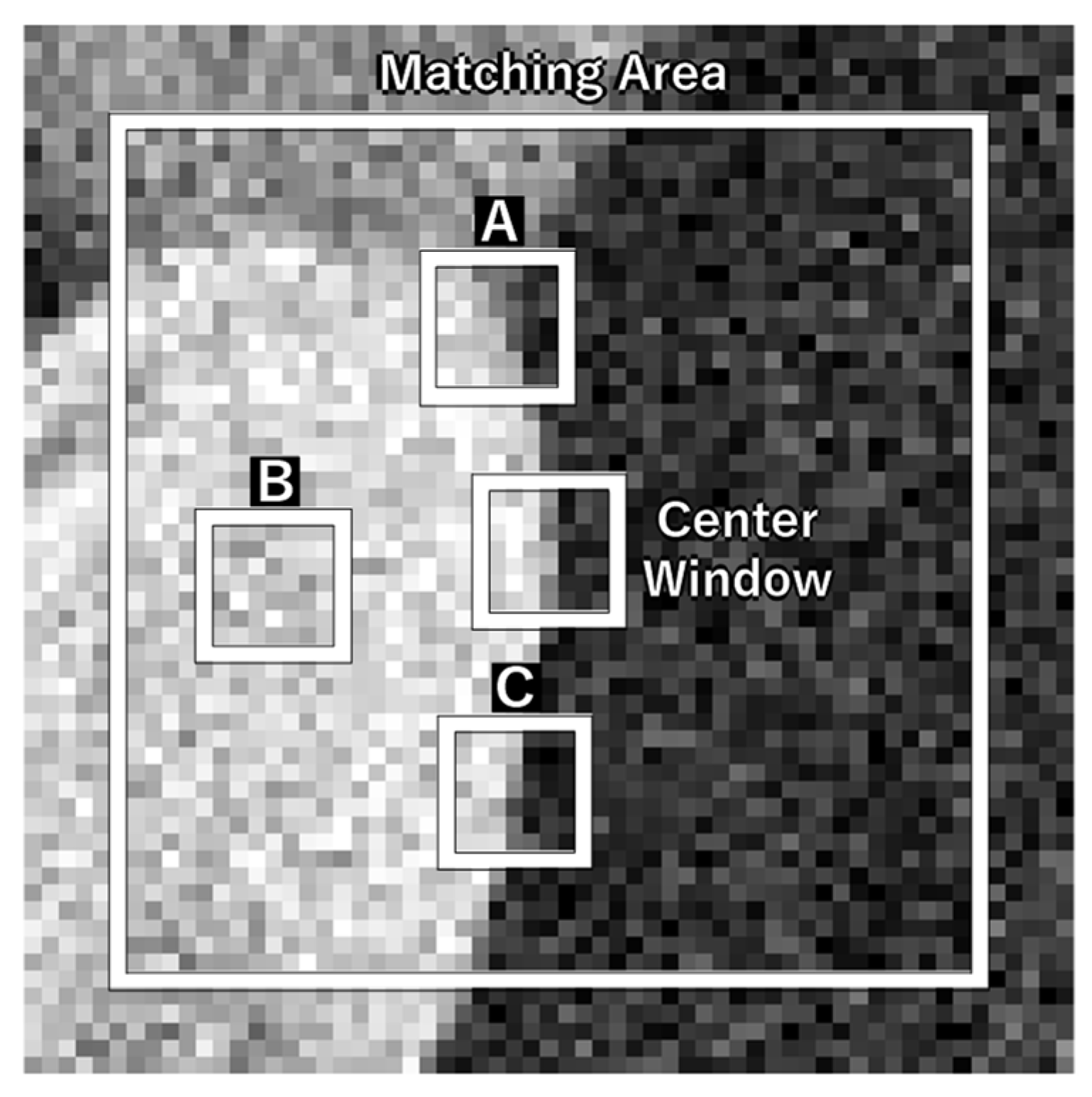

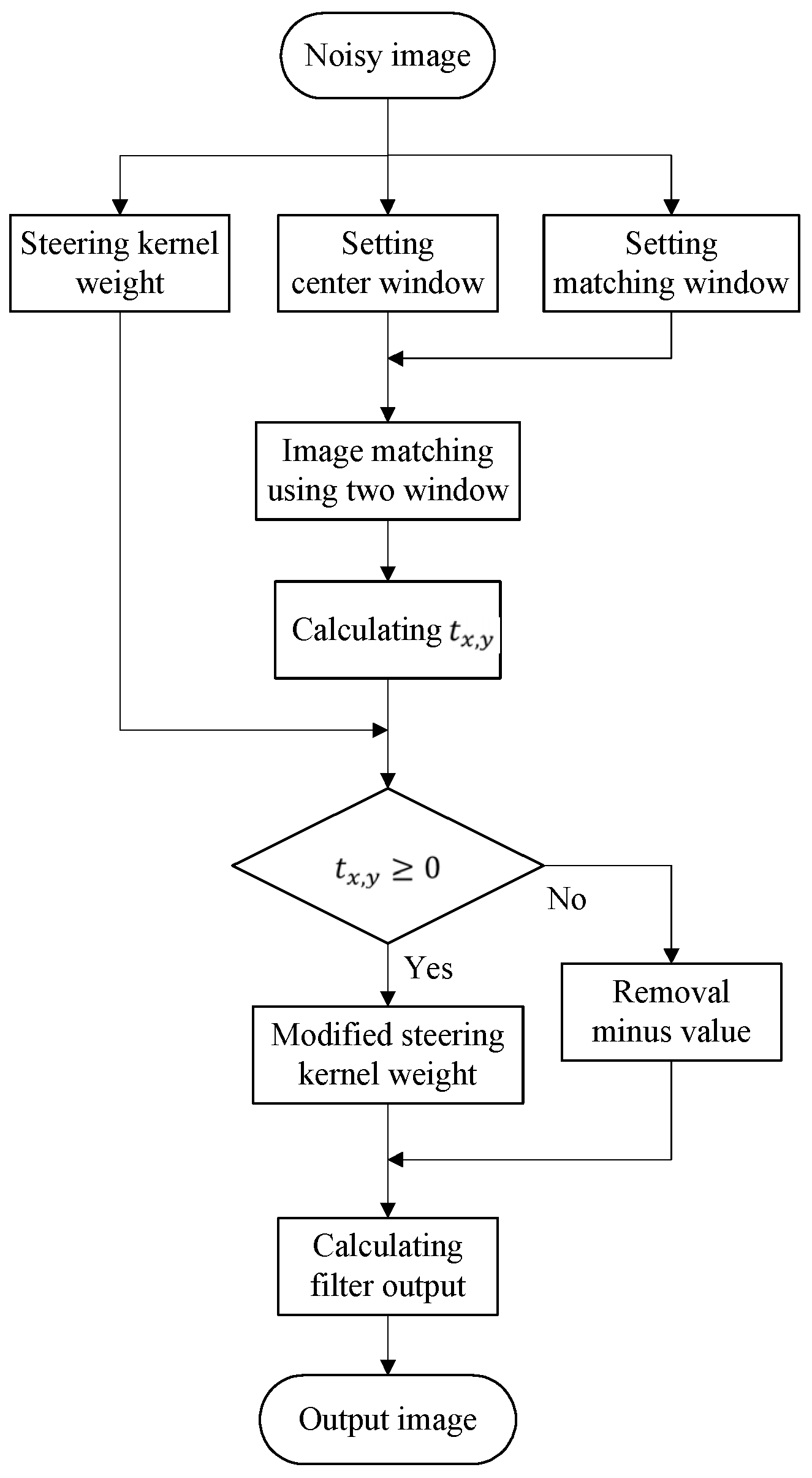


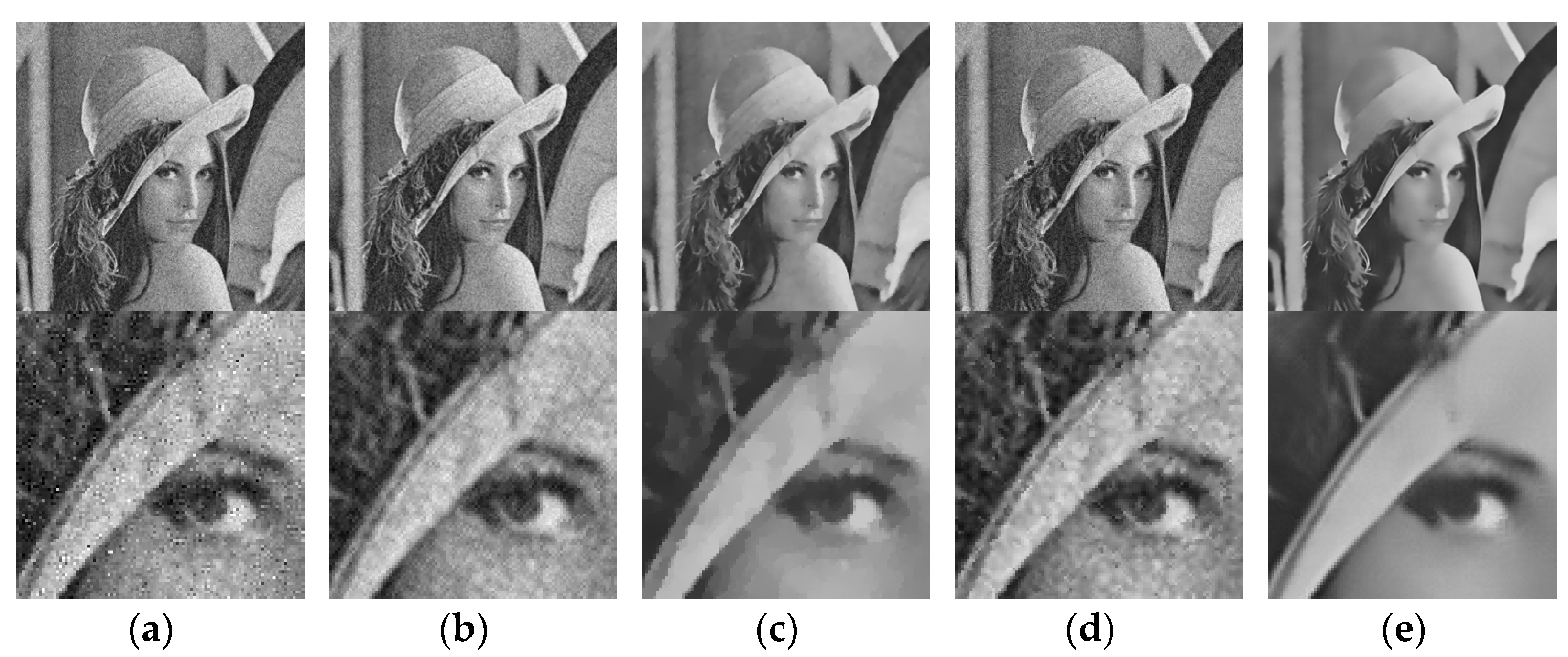
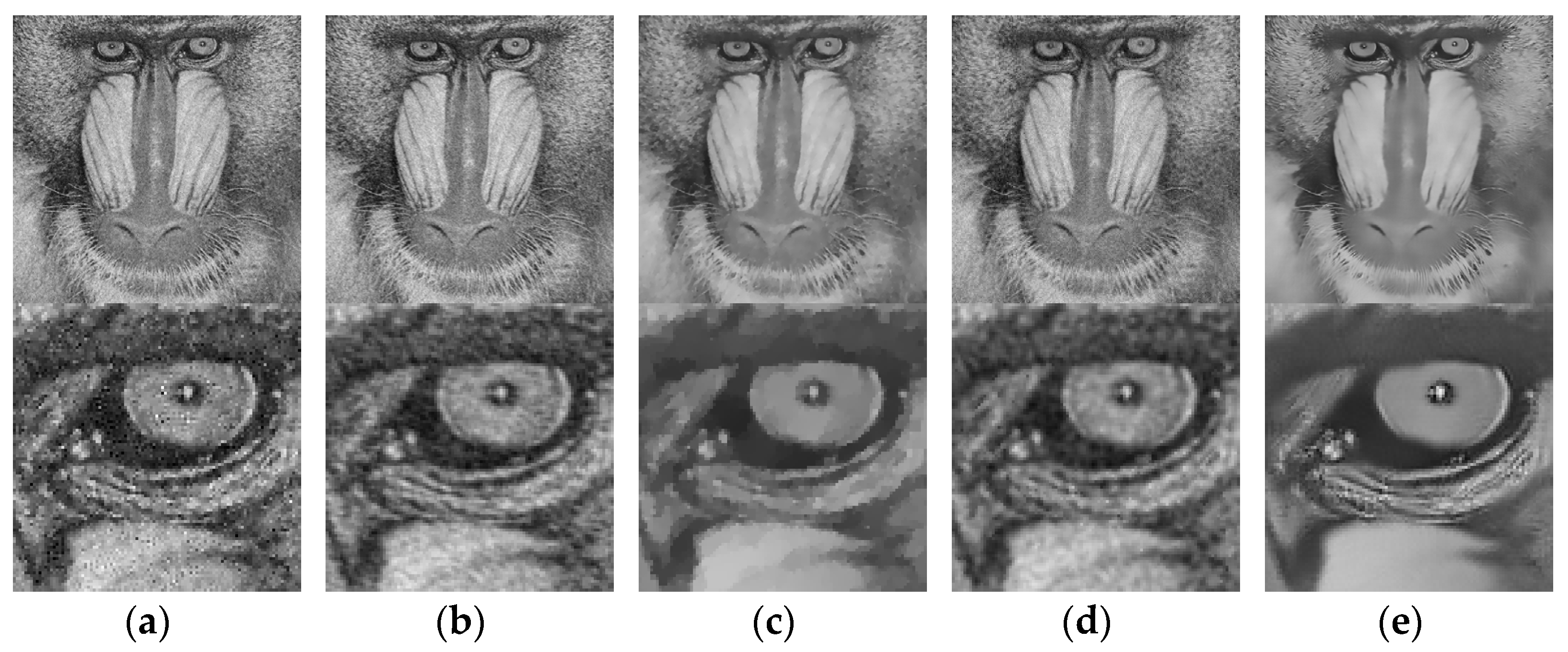
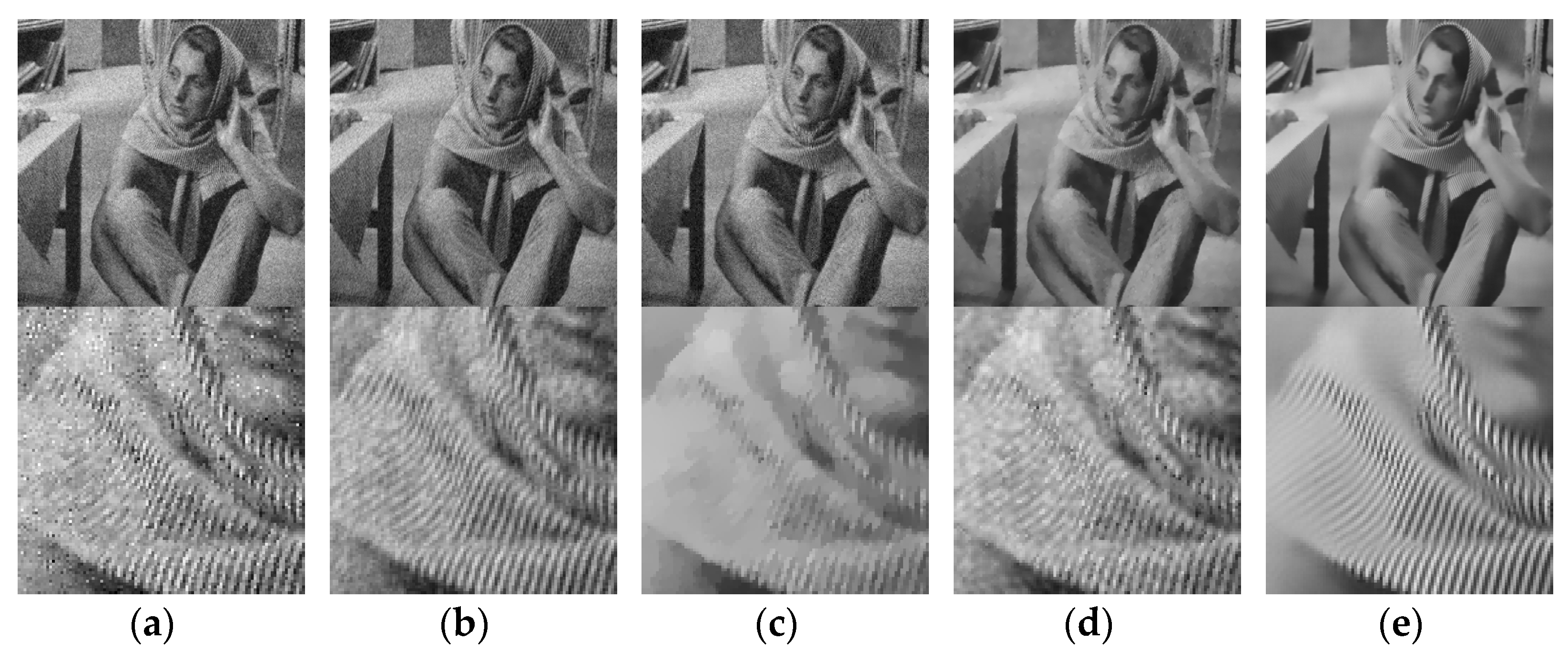

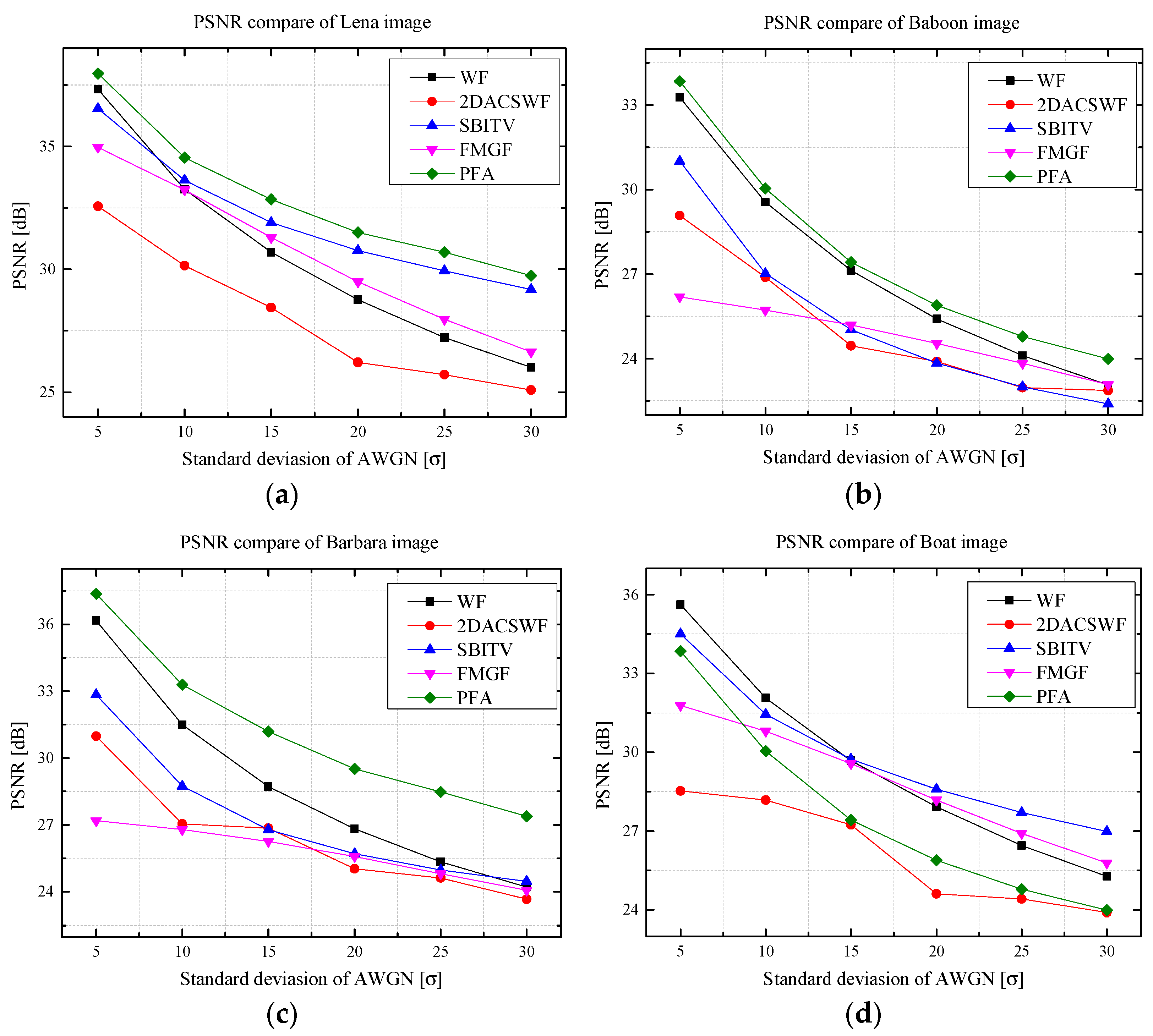
| Parameter | Variable | Value |
|---|---|---|
| Window size parameter | ||
| Smoothing parameter | 1.5 | |
| Matching area size | 10 | |
| Filter weight threshold | 1.5 |
| Image | AWGN [] | WF | 2DACSWF | SBITV | FMGF | PFA | |||||
|---|---|---|---|---|---|---|---|---|---|---|---|
| PSNR [dB] | SSIM | PSNR [dB] | SSIM | PSNR [dB] | SSIM | PSNR [dB] | SSIM | PSNR [dB] | SSIM | ||
| Lena | 5 | 37.33 | 0.9280 | 32.57 | 0.7996 | 36.54 | 0.9224 | 34.97 | 0.9189 | 37.97 | 0.9380 |
| 10 | 33.25 | 0.8498 | 30.15 | 0.6393 | 33.62 | 0.8832 | 33.23 | 0.8619 | 34.54 | 0.8952 | |
| 15 | 30.69 | 0.7631 | 28.44 | 0.6460 | 31.90 | 0.8554 | 31.29 | 0.7876 | 32.84 | 0.8684 | |
| 20 | 28.76 | 0.6767 | 26.21 | 0.5331 | 30.76 | 0.8332 | 29.49 | 0.7056 | 31.50 | 0.8418 | |
| 25 | 27.22 | 0.6017 | 25.71 | 0.5417 | 29.94 | 0.8170 | 27.96 | 0.6330 | 30.69 | 0.8197 | |
| 30 | 26.00 | 0.5379 | 25.08 | 0.4863 | 29.18 | 0.7994 | 26.64 | 0.5650 | 29.74 | 0.7980 | |
| Baboon | 5 | 33.27 | 0.9108 | 29.08 | 0.8712 | 31.01 | 0.9145 | 26.19 | 0.6779 | 33.84 | 0.9148 |
| 10 | 29.55 | 0.8615 | 26.89 | 0.7745 | 27.02 | 0.8128 | 25.73 | 0.6019 | 30.04 | 0.8700 | |
| 15 | 27.13 | 0.7204 | 24.46 | 0.6612 | 25.03 | 0.7244 | 25.19 | 0.5360 | 27.42 | 0.7778 | |
| 20 | 25.41 | 0.7148 | 23.90 | 0.6156 | 23.84 | 0.6536 | 24.54 | 0.4806 | 25.89 | 0.7201 | |
| 25 | 24.11 | 0.6126 | 22.97 | 0.5916 | 23.00 | 0.5958 | 23.83 | 0.4311 | 24.79 | 0.6264 | |
| 30 | 23.07 | 0.5328 | 22.87 | 0.5492 | 22.39 | 0.5470 | 23.08 | 0.3893 | 23.99 | 0.5611 | |
| Barbara | 5 | 36.17 | 0.9442 | 30.98 | 0.7274 | 32.84 | 0.9230 | 27.19 | 0.8383 | 37.37 | 0.9527 |
| 10 | 31.50 | 0.8780 | 27.05 | 0.5529 | 28.74 | 0.8438 | 26.80 | 0.7977 | 33.29 | 0.9196 | |
| 15 | 28.72 | 0.7930 | 26.85 | 0.5289 | 26.79 | 0.7803 | 26.26 | 0.7423 | 31.19 | 0.8911 | |
| 20 | 26.83 | 0.7100 | 25.03 | 0.4575 | 25.71 | 0.7350 | 25.59 | 0.6809 | 29.52 | 0.8545 | |
| 25 | 25.35 | 0.6330 | 24.62 | 0.4285 | 24.98 | 0.7019 | 24.81 | 0.6179 | 28.49 | 0.8193 | |
| 30 | 24.21 | 0.5669 | 23.67 | 0.3591 | 24.47 | 0.6761 | 24.07 | 0.5603 | 27.39 | 0.7809 | |
| Boat | 5 | 35.62 | 0.9061 | 28.53 | 0.8394 | 34.50 | 0.8946 | 31.78 | 0.8747 | 36.28 | 0.9137 |
| 10 | 32.06 | 0.8420 | 28.18 | 0.6891 | 31.44 | 0.8348 | 30.80 | 0.8342 | 33.01 | 0.8694 | |
| 15 | 29.68 | 0.7682 | 27.24 | 0.6827 | 29.73 | 0.7905 | 29.57 | 0.7790 | 30.84 | 0.8066 | |
| 20 | 27.92 | 0.6961 | 24.61 | 0.5753 | 28.59 | 0.7566 | 28.18 | 0.7139 | 29.55 | 0.7669 | |
| 25 | 26.45 | 0.6288 | 24.42 | 0.5352 | 27.70 | 0.7292 | 26.91 | 0.6508 | 28.58 | 0.7155 | |
| 30 | 25.27 | 0.5685 | 23.90 | 0.5037 | 26.98 | 0.7055 | 25.78 | 0.5916 | 27.74 | 0.6849 | |
Publisher’s Note: MDPI stays neutral with regard to jurisdictional claims in published maps and institutional affiliations. |
© 2022 by the authors. Licensee MDPI, Basel, Switzerland. This article is an open access article distributed under the terms and conditions of the Creative Commons Attribution (CC BY) license (https://creativecommons.org/licenses/by/4.0/).
Share and Cite
Cheon, B.-W.; Kim, N.-H. AWGN Removal Using Modified Steering Kernel and Image Matching. Appl. Sci. 2022, 12, 11588. https://doi.org/10.3390/app122211588
Cheon B-W, Kim N-H. AWGN Removal Using Modified Steering Kernel and Image Matching. Applied Sciences. 2022; 12(22):11588. https://doi.org/10.3390/app122211588
Chicago/Turabian StyleCheon, Bong-Won, and Nam-Ho Kim. 2022. "AWGN Removal Using Modified Steering Kernel and Image Matching" Applied Sciences 12, no. 22: 11588. https://doi.org/10.3390/app122211588
APA StyleCheon, B.-W., & Kim, N.-H. (2022). AWGN Removal Using Modified Steering Kernel and Image Matching. Applied Sciences, 12(22), 11588. https://doi.org/10.3390/app122211588






